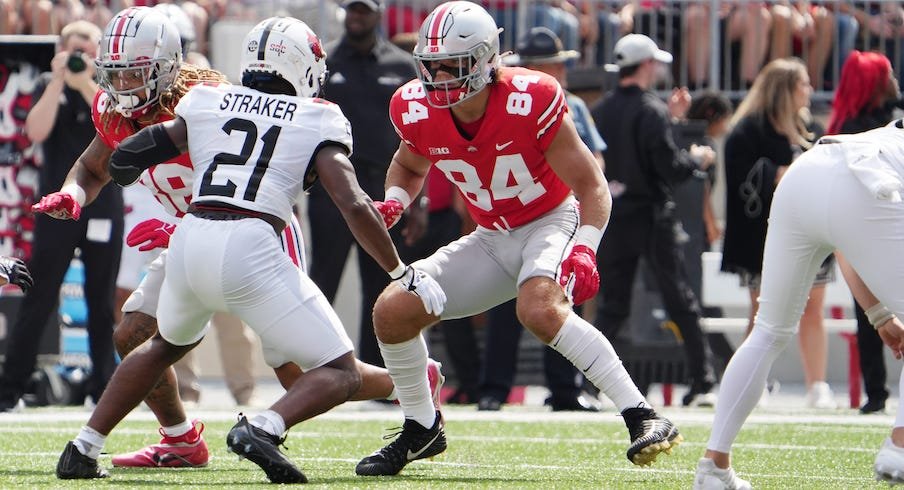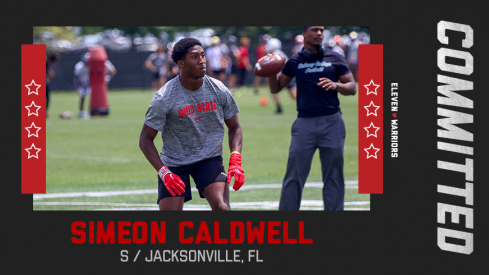Former Santa Clara standout Christoph Tilly, a top-10 center in the transfer portal, commits to Ohio State.
Ohio State enters the 2023 season needing to replace five players who played significant roles on the Buckeyes’ offense in 2022.
Four of those players are obvious. The Buckeyes need to find a new starting quarterback to replace C.J. Stroud, they need two new starting offensive tackles to step up to replace Paris Johnson Jr. and Dawand Jones, and they need a new starting center to fill the void left by Luke Wypler’s departure.
The more quietly important player from last year’s offense the Buckeyes must replace is Mitch Rossi. While the emergence of a fullback/secondary tight end certainly isn’t as pressing as Kyle McCord or Devin Brown filling Stroud’s shoes or three new starting offensive linemen being capable of protecting the quarterback, Ohio State will still be looking to fill Rossi’s shoes in some form or fashion.
While Rossi touched the ball only 11 times (five carries, six catches) over the past two seasons, he was one of the Buckeyes’ best run blockers and a valuable chess piece in the offense. He was utilized both as a fullback lining up in the backfield and as an in-line tight end and even occasionally lined up at running back – most notably in the fourth quarter of the Peach Bowl against Georgia – in situations where pass-blocking was at a premium.
Entering spring, there isn’t an obvious candidate to play that role for Ohio State in 2023. While Rossi was built to play fullback at 6-foot-1 and 250 pounds, all of Ohio State’s current scholarship tight ends are taller players who profile more naturally as traditional in-line tight ends or as flex tight ends who play like big wide receivers.
New Ohio State tight ends coach Keenan Bailey believes he has players capable of playing the fullback role. But he also says Ohio State will build its offense around the strength of its personnel, which could mean the Buckeyes’ multi-tight end looks having a different look this year than they did with Rossi.
“I think each year in college football, you gotta cater your offense to your personnel,” Bailey said on Feb. 1. “Mitch gave us tremendous value, a unique skill set, so we kind of catered things there. We've got some guys to answer your question, yes, that could be that fullback role. But we've also got some other guys who could play a receiver/tight end hybrid. I mean, look around the NFL. Whether it's the Niners or the Dolphins or the Rams, more positionless players who can do a lot of things. I think our tight end room is full of versatile guys.”
With Cade Stover returning as Ohio State’s starting tight end, the leading candidates to be the No. 2 tight end on the depth chart behind him are Gee Scott Jr. and Joe Royer. Both of them project best to playing the flex tight end role – especially Scott, considering he started his Ohio State career as a wide receiver – and could give Ohio State another downfield receiving threat at the position along with Stover, whose 36 receptions in 2022 were the most by an Ohio State tight end in 25 years.
While the Buckeyes remain loaded at wide receiver with Marvin Harrison Jr., Emeka Egbuka and Julian Fleming all returning for another year, a hybrid tight end playing regularly could make Ohio State’s receiving corps even tougher to cover.
“If you watch how football is going, tight ends can be a mismatch nightmare,” Bailey said.
Rossi only actually lined up in the backfield for 79 of his 286 offensive snaps last season, per Pro Football Focus, so the need to replace him at fullback – if Ohio State determines there is one – would only be for situational purposes. That said, it is vital for at least one of the Buckeyes’ backup tight ends to establish himself as a reliable blocker like Rossi was, especially with the uncertainty Ohio State has at tackle.
Sam Hart, Bennett Christian, Jelani Thurman and even walk-ons like Patrick Gurd and Zak Herbstreit will also be vying for position on the depth chart this spring and showing they can add value as a blocker – whether as an in-line tight end, in the backfield as a fullback or flexed out as a receiver – could be what earns one of them a role in Ohio State’s offense this year. But Bailey doesn’t want any of his tight ends to be one-dimensional.
“Having that versatility is really to keep defenders and defensive coordinators on their heels … it's gonna be huge in the pass game, it’s gonna be huge in the run game, huge in the protection game,” Bailey said. “I mean, you're playing left tackle and X receiver … at Ohio State, one play you got to block the best pass rusher on their defense, and then the next play, depending on coverage, I gotta get open against their best coverage guy.”
Ohio State’s tight ends have plenty to prove this season; even Stover, who Bailey said would “be the first one to tell you” he still has to improve this year. But while it remains uncertain how the tight end depth chart behind Stover will stack up and how Ohio State will deploy its tight ends within the offense this season, Bailey is optimistic about what his unit can accomplish in 2023.
“It’s a deep room full of versatile guys, starting with Cade,” Bailey said. “Joe, Gee, all those guys … I mean, they're the most gifted athletes in the country. We're Ohio State. So the sky's the limit.”


